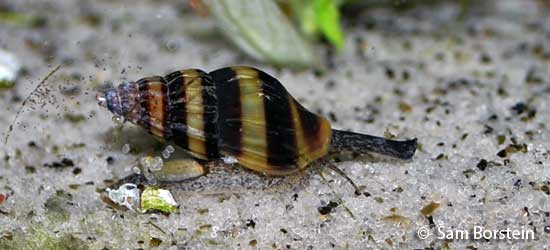Clea helena
(Busch, 1847)
Assassin Snail, Killer Snail
Synonyms: Anentome helena

Above: An Assassin Snail. Photo by Sam Borstein.
Etymology:
Genus- Clea= Not sure, but I believe it is named after Cleopatra.
Species- helena= named after the goddess (Greek).
Intro:
Assassin Snails are a very attractive snail species from Asia. These snails are actually a freshwater whelk. This carnivorous species, typed by Busch in 1847, is known to be an excellent predator of Melanoides species, the Malaysian Trumpet Snails. For this reason, they are highly sought after by aquarists with snail problems.
The scientific name of this fish has been juggled around for quite a while. There was not much online and I took the most reliable source I could find, gastropods.com. I'm by no means a snail expert. This species is currently in the subgenus Anentome. At one point the snails were called Anentome helena.
This species rips snails out of the shells, which can be seen once in a while. They will do a good job keeping the population of pest snails down, but aren't great hunters. They need to move and run into the other snail to find it and kill it. This species is remarkably fast for a snail.
Distribution:
Assassin Snails can be found in sandy streams and creeks of South East Asia. They can be found in Thailand and Indonesia.
Size, Maturity, and Sexual Dimorphism:
Size: 2 inchesMaturity: 1 inch
Care:
Killer Snails are very simple to care for. They do well in a tank with a sand substrate. You can put plants in the tank, as they will not be harmed. Fish will also not be harmed. They are tolerant of many water conditions.
Assassin Snails should not be kept with any other snail species that you would like to live. They are efficient predators and will eradicate them. There are conflicting reports on whether or not this species will hunt small freshwater shrimp, so keep that in mind if you consider adding one to your invert tank.
Diet:
Like said above, Assassin Snails are snail eaters and carnivorous. They will also scavenge the tank for uneaten fish food and dead fish.

Above: Clea helena hunting down a Malaysian Trumpet Snail. Photos by Sam Borstein.
Breeding:
Assassin Snails are not hermaphroditic, so you need a male and female snail. I don't know how to sex these snails. It is common to see the snail mating as they will stick to each other for long periods of time(4+ hours). From my experience, females will carry sperm and fertilize and lay the eggs at a different time, similar to some Xiphophorus.
Although they had numerous babies, I don't believe this species lays a lot of eggs. The fry are easy to raise, but stay in the substrate until a 1/4 of an inch, which is a few months. They grow quickly and can be seen motoring throughout the tank.
Conclusion:
Assassin Snails are great and beautiful creatures. They will solve your snail problem and are a pleasure to keep. They are slightly hard to find.
